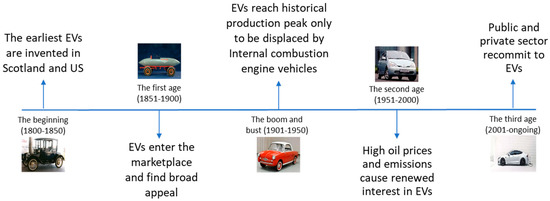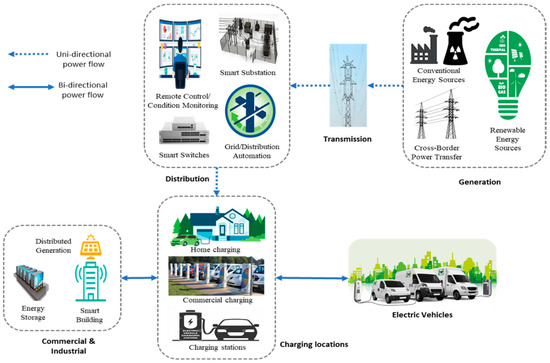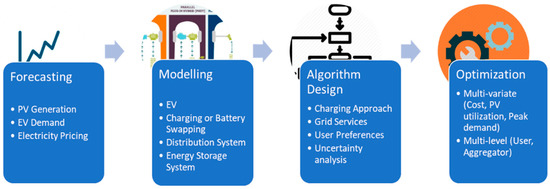Electric vehicles (EVs) are one of a prominent solution for the sustainability issues needing dire attention like global warming, depleting fossil fuel reserves, and greenhouse gas (GHG) emissions. Conversely, EVs are shown to emit higher emissions (measured from source to tailpipe) for the fossil fuel-based countries, which necessitates renewable energy sources (RES) for maximizing EV benefits. EVs can also act as a storage system, to mitigate the challenges associated with RES and to provide the grid with ancillary services, such as voltage regulation, frequency regulation, spinning reserve, etc. For extracting maximum benefits from EVs and minimizing the associated impact on the distribution network, modelling optimal integration of EVs in the network is required.
- plug-in electric vehicle
- energy management system
- renewable energy
- vehicle-to-grid
Please note: Below is an entry draft based on your paper, which is written tightly around the entry title. Since it may not be very comprehensive, we kindly invite you to modify it (both title and content can be replaced) according to your extensive expertise. We believe this entry would be beneficial to highlight your work.
1. Introduction
The issues like global warming, depleting fossil fuel reserves, and greenhouse gas (GHG) emissions need dire attention for ensuring a sustainable future. Because the transportation sector is one of the largest contributors to the rising harmful emissions, the electrification of transportation is seen as a promising solution for this problem. Electric vehicle (EV) technology has existed for more than a century peaking commercially around 1900. However, due to the easy availability of fossil fuels, advancements in internal combustion (IC) technology, and simplicity in the use of IC engines, EVs were put on hold and limited to golf carts and delivery vehicles. Figure 1 shows the progression timeline of the EVs. The dependency on petroleum imports for transportation purposes is also reduced by electrification of transportation, thereby increasing energy security. However, the adoption rate of EVs remains slow owing to factors, such as high initial cost, battery degradation, inadequate charging infrastructure, range anxiety, etc. [1]. Various policies and incentives are made available by governments around the world to promote the uptake of EV and to prevent these barriers from realizing a complete shift to electrified transportation. As per the report “Global EV outlook” of the International Energy Agency, the total number of EVs are projected to reach 130 million by 2030 [2].

However, high penetration of EVs also poses distribution network quality issues, particularly network congestion, three-phase voltage imbalance and off-nominal frequency problems. The EVs are a mobile single-phase load so they can be randomly plugged in at any one of three phases within distribution networks, leading to a scenario that electrical components in one particular phase, such as power supply cable, overhead line or transformer may be heavily loaded while the rest of two phases are not. The unbalanced three-phase loading may lead to a series of negative impact on power quality issue: Transformer failures, equipment loss-of-life, relay misfunction, etc. Moreover, as EVs are highly spatial and temporally uncertain, handling EVs as additional loads while maintaining the reliability and security of the grid is difficult. The coincidence of timing between EV home charging and residential load peaks leads to additional system peaks. Moreover, multiple EV chargers in a neighbourhood can introduce significant harmonics, thereby reducing power quality [3]. Therefore, the integration of substantial EV penetration in the distribution networks is a significant area of interest in the research and engineering community, especially optimally controlling EV charging to minimise the impact of the above-described issues.
Another significant contributor to harmful emissions is the power industry, particularly fossil fuel-based power generation. Renewable energy sources (RES), such as wind and solar are increasingly adopted to mitigate the power industry emissions. The variable nature of RES which depends on the weather, time, location, etc. creates voltage stability and reliability issues for the power grid requiring integration of Energy Storage System (ESS). Also, there may not be sufficient demand requirement during the period of high RES generation, which leads to the under-utilisation of average generated capacity. Using ESS with RES can result in its effective utilisation as ESS can store energy when demand is low and supply back when demand is high. Apart from using ESS, application of demand-side management techniques like load shifting, time of use pricing, and demand bidding can also solve the aforementioned problems associated with RES although the impact of these techniques is limited compared to ESS [4,5].
2. EV Interaction with the Distribution Network

-
Vehicle-to-grid (V2G): Energy transfer from EV to the distribution network.
-
Vehicle-to-home/building (V2H/V2B): Energy transfer from EV to home/building.
-
Vehicle-to-vehicle (V2V): Energy transfer from one EV to another EV.
3. Modelling of Grid-Connected EV-PV System
The sustainability of EV depends on the source of charging. All forms of EVs, i.e., plug-in electric vehicle (PEV), hybrid electric vehicle (HEV), or plug-in hybrid electric vehicle (PHEV), have lower emissions if the energy supplied for charging is based on clean fuel, such as renewable sources. However, contrary to popular belief if the EVs are charged from fossil fuel or gas-based generation, the emissions are significant and not zero. The RES, i.e., PV, wind, tidal, geothermal, or hydro, are excellent options to power electric vehicles. Moreover, the following reasons make PV an admirable source to charge the EVs:
-
The cost of PV has been dropping continuously and is currently less than $1/Wp [32].
-
PV is highly accessible, i.e., PV modules are generally installed on the building rooftops and carparks, close to EV locations.
-
PV modules do not require maintenance and are also noise-free.
Figure 3 shows a general framework for designing a smart charging system for integrating EV-PV system into the grid.

The control architectures for grid-connected EVs (with or without PVs) can be categorised into the following three methodologies:
-
Centralised scheduling;
-
Decentralised scheduling;
-
Price-varying scheduling.
4. EV Smart Charging Using PV and Grid
Multiple studies have explored the advantages of a PV based EV charging system. Reference [55] demonstrates the advantage of using PV to charge the EV and show that it allows for greater penetration of both PV and EV. EVs can also mitigate the negative effects of excess PV generation [56]. Reference [57] presents a case study of Columbus, USA, in which it is demonstrated that charging EV from the PV is more economical and produces less CO2 footprint than charging EV from the grid. A case study presented in Reference [58] compares charging of EVs through the modes: Only grid, only PV with battery storage and grid integrated PV and finds that the grid integrated PV performs better economically compared to the other two systems. In Reference [59], the authors discuss the application of PV energy and EV as an energy storage system to mitigate the peak loading in the grid. These studies demonstrate the advantages of PV based EV charging over grid EV charging. There is a vast amount of literature on different charging algorithms or achieving different economic, technical, or social objectives related to PV based EV charging.
5. Conclusions
This entry is adapted from the peer-reviewed paper 10.3390/en13174541
